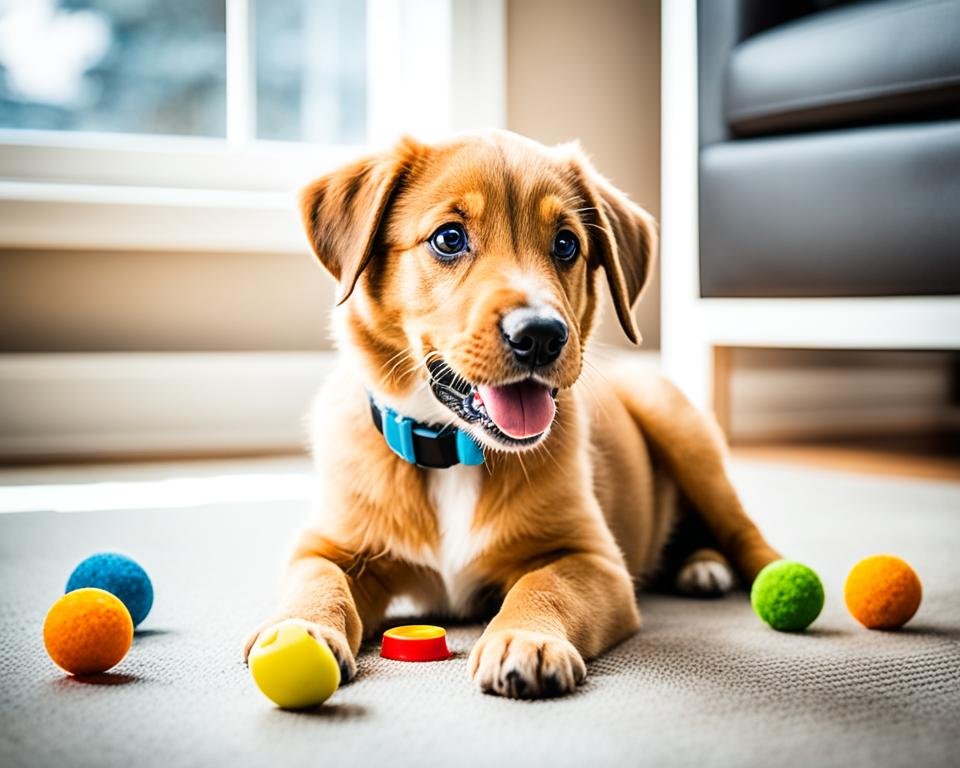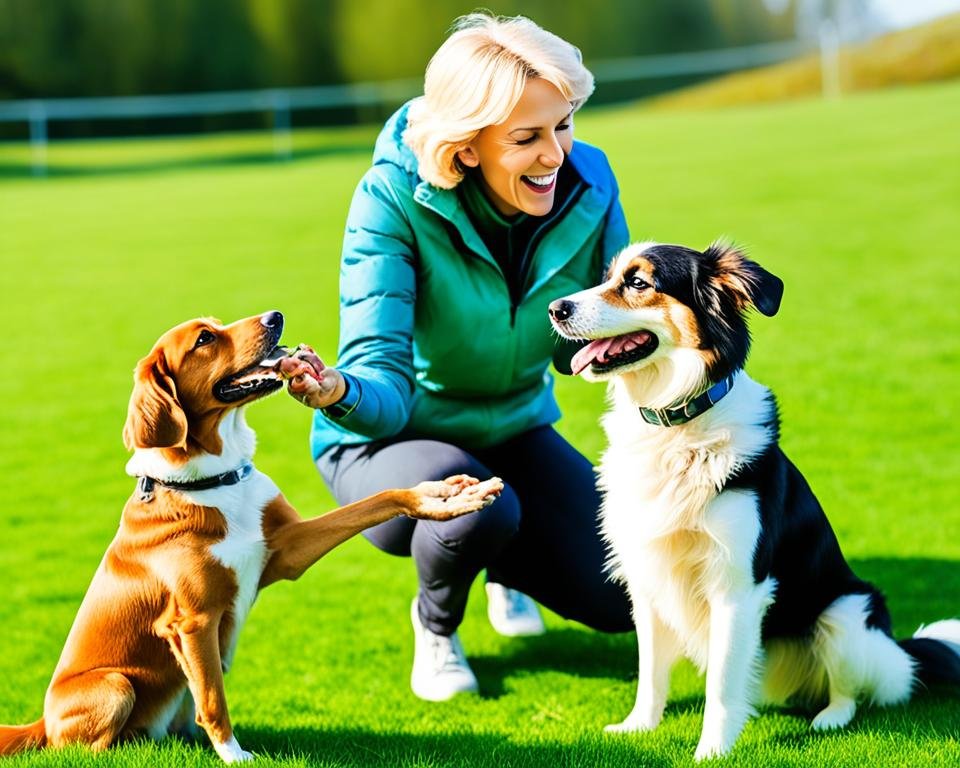Training your pet can bring immense joy and fulfillment to both you and your furry friend. By successfully training your pet, you can establish a strong bond, improve their behavior, and ensure their safety and well-being. Whether you have a dog, cat, or puppy, training them is an integral part of responsible pet ownership. In this article, we will explore the benefits of training your pet and provide valuable tips and techniques for successful pet training.
Key Takeaways:
- Training your pet can strengthen the bond between you and your furry friend.
- Successful pet training leads to improved behavior and ensures your pet’s safety.
- Responsible pet ownership includes training your dog, cat, or puppy.
- Training your pet is a rewarding experience that brings joy to both parties.
- Stay tuned to learn valuable tips and techniques for successful pet training!
The Integral Role of Obedience Training in Pet Welfare
Obedience training plays a crucial role in ensuring the welfare and well-being of your pet. Not only does it improve their behavior, but it also enhances their safety in various situations. By teaching your pet obedience commands such as sit, stay, and come, you can prevent accidents and protect them from potential dangers.
The Link Between Obedience Commands and Pet Safety
Obedience commands serve as a vital communication tool between you and your pet. When trained to respond to these commands consistently, your pet will be better equipped to navigate their environment safely. For instance, teaching your dog to “sit” and “stay” can prevent them from darting into oncoming traffic or approaching hazardous objects. Similarly, training your cat to come when called can help retrieve them from dangerous situations, both indoors and outdoors.
How Obedience Training Prevents Shelter Overcrowding
One of the lesser-known benefits of obedience training is its impact on shelter overcrowding. Pets that exhibit behavioral problems are often surrendered to shelters, leading to overcrowding and limited resources for other animals in need. By investing time and effort into proper obedience training, you can significantly reduce the likelihood of your pet developing behavior issues that could result in surrender.
When pets are well-trained and obedient, they are more likely to be seen as desirable companions and find their forever homes. This not only improves their individual welfare but also helps alleviate the strain on overcrowded shelters. By training your pet for obedience, you are actively contributing to the well-being of animals in need.
Understanding Behavioral Training for Household Harmony
Behavioral training plays a crucial role in creating a harmonious environment in your home. It involves addressing common behavioral issues and implementing expert strategies to modify your pet’s behavior. By understanding the root causes of these issues and employing effective training techniques, you can significantly improve your pet’s behavior and enhance the overall harmony in your household.
Addressing Common Behavioral Issues with Expert Strategies
Common behavioral issues, such as destructive chewing and excessive barking, can disrupt the peace in your home. However, with the right strategies, these issues can be successfully addressed. Here are a few expert techniques to tackle common behavioral problems:
- Positive reinforcement: Rewarding positive behavior can encourage your pet to repeat those actions.
- Consistency: Establishing a consistent routine helps your pet understand what is expected of them.
- Redirecting behavior: Providing appropriate alternatives to undesirable behaviors can help redirect your pet’s focus.
- Environmental enrichment: Engaging your pet with toys, puzzles, and mental stimulation can reduce boredom and unwanted behaviors.
Implementing these expert strategies can help you overcome common behavioral issues and create a well-behaved and happy pet.
From Destructive Chewing to Positive Behaviors: A Transformation
Destructive chewing is a common behavioral issue among pets, especially puppies. However, with behavioral training, you can transform this destructive behavior into positive habits. Here’s how:
- Identify the cause: Understand why your pet is engaging in destructive chewing, such as teething or boredom.
- Provide appropriate chew toys: Offer a variety of chew toys designed for your pet’s size and chewing preferences.
- Supervise and redirect: Keep a close eye on your pet and redirect their chewing to the appropriate toys whenever necessary.
- Reward positive chewing behavior: Praise and reward your pet when they chew on their designated toys instead of household items.
With patience, consistency, and the right training techniques, you can guide your pet towards positive behaviors and eliminate destructive chewing.

Training Your Pet for Success: Establishing Leadership
Establishing leadership in your household is essential for successfully training your pet. By understanding the psychology of pack dynamics in domestic pets, you can effectively establish yourself as the leader and cultivate respect and authority within your household. This lays the foundation for a balanced and harmonious relationship with your pet, ensuring their success in training.
The Psychology of Pack Dynamics in Domestic Pets
Domestic pets, such as dogs and cats, have innate pack instincts inherited from their wild ancestors. These instincts drive them to seek a hierarchical structure within their social group. Understanding and embracing this psychology allows you to tap into their natural instincts and establish yourself as the leader.
Just like in the wild, pets recognize and respond to strong leadership. By assuming the role of the pack leader, you gain their trust, which is crucial for effective training. It is important to note that establishing leadership does not involve harsh punishment or dominance-based techniques. Instead, it relies on clear communication, consistency, and positive reinforcement.
Cultivating Respect and Authority in Your Household
Cultivating respect and authority in your household starts with consistent training and setting clear boundaries. It is essential to establish rules and expectations that your pet understands and follows. Be firm but fair in your approach, using positive reinforcement to reward good behavior and redirect undesired behavior.
Consistency is key when cultivating respect and authority. Maintain a consistent daily routine, enforce rules consistently, and ensure that all family members are on the same page when it comes to training and expectations. This creates a structured environment that fosters respect and encourages your pet to look to you for guidance and leadership.
Remember, leadership is not about dominance or control. It is about earning your pet’s trust and respect through positive and consistent training techniques. When you establish yourself as a confident and compassionate leader, you create an environment where your pet feels safe, secure, and willing to follow your guidance. This sets the stage for successful training and a strong bond with your furry companion.
https://www.youtube.com/watch?v=zLLpNzClcFo
Puppy Training: Laying the Foundation for a Well-behaved Companion
Puppy training is crucial in laying the foundation for a well-behaved companion. Training your puppy from an early age helps them develop good habits, learn basic obedience commands, and socialize with other animals and people. By investing time and effort in puppy training, you are setting your furry friend up for a lifetime of positive behavior and a strong bond with you.

During the early stages of a puppy’s life, they have a remarkable ability to learn and adapt. This critical period is the perfect time to introduce them to the essentials of behavior and obedience training. By implementing proper training techniques and positive reinforcement, you can shape their behavior and help them grow into a well-mannered adult dog.
One of the key aspects of puppy training is teaching them basic obedience commands such as sit, stay, and come. These commands not only facilitate better control and safety but also foster a sense of discipline and respect in your puppy. Consistency and repetition are essential when teaching these commands, and using rewards such as treats or praise can further incentivize their learning process.
Socialization is another vital element of puppy training. Proper socialization helps puppies develop confidence, ease anxiety, and learn appropriate behavior around other animals and people. Introducing your puppy to various environments, experiences, and stimuli from an early age can help them become well-adjusted and friendly companions.
It’s important to remember that puppy training requires patience, consistency, and positive reinforcement. Punishment-based methods are not recommended as they can lead to fear and confusion in puppies. Instead, focus on rewarding desired behaviors and redirecting unwanted behaviors using positive reinforcement techniques.
By investing time and effort into puppy training, you are not only shaping your puppy’s behavior but also establishing a strong bond with them. The effort you put into training will pay off in the form of a well-behaved companion who brings joy and happiness to your life for years to come.
“The journey of puppy training is an opportunity for both you and your furry friend to grow together. Embrace this time, be patient, and enjoy the process of nurturing a well-behaved and loving companion.”
Essential Puppy Training Tips
| Tip | Description |
|---|---|
| Start Early | Begin training your puppy as soon as you bring them home to establish good habits from the start. |
| Be Consistent | Use consistent commands, routines, and rewards to reinforce desired behaviors consistently. |
| Use Positive Reinforcement | Reward your puppy with treats, praise, or playtime to encourage and reinforce positive behaviors. |
| Socialize Often | Expose your puppy to a variety of people, animals, and environments to help them become well-adjusted and friendly. |
| Patience is Key | Remember that puppies are still learning, and training takes time. Stay patient and consistent in your approach. |
Positive Reinforcement: Building Trust Through Rewards
Positive reinforcement is a highly effective training technique that involves rewarding desired behavior to build trust and strengthen the bond between you and your pet. By using rewards such as treats, praise, and playtime, you can reinforce positive behaviors and encourage your pet to repeat them. Positive reinforcement training techniques are based on the principles of kindness, consistency, and clear communication, making it a humane and successful approach to pet training.
When using positive reinforcement, it’s important to focus on rewarding the behavior you want to encourage rather than punishing or correcting undesired behavior. This method helps your pet associate the desired behavior with positive outcomes and builds their trust in you as their trainer. It creates a positive learning environment and motivates them to engage in training.
One of the key advantages of positive reinforcement is that it helps to establish a strong bond between you and your pet. By using rewards and positive feedback, you create a positive association with training sessions, making them enjoyable for both you and your furry friend. This strengthens your relationship and enhances overall communication.
It’s essential to be consistent in your use of rewards and to provide them immediately after the desired behavior occurs. This helps your pet to make the connection between their actions and the reward. With consistent practice and repetition, your pet will learn that certain behaviors are rewarded and will be motivated to exhibit them more frequently.
Remember that every pet is unique, and what motivates one may not work for another. Experiment with different types of rewards to find out what your pet responds to best. It could be a favorite treat, a favorite toy, or even verbal praise and affection. Tailor your rewards to your pet’s preferences and needs.

Positive reinforcement training techniques can be used for a wide range of behaviors, from basic obedience commands to complex tricks and tasks. It is effective for dogs, cats, and other animals, regardless of age or breed. The key is to be patient, consistent, and positive throughout the training process.
In addition to building trust and strengthening the bond between you and your pet, positive reinforcement training techniques have been shown to have long-lasting effects. Unlike punishment-based methods that may lead to fear or anxiety, positive reinforcement creates a positive association with training and ensures that your pet looks forward to learning and engaging with you.
In the next section, we will delve into behavior modification techniques that address the root causes of misbehavior, helping you create lasting good behavior in your pet.
Behavior Modification for Pets: Addressing the Root Causes
Behavior modification is an essential aspect of pet training that focuses on addressing the underlying causes of misbehavior. When pets misbehave, it is essential to understand why they exhibit certain behaviors in order to implement effective changes.
Understanding Why Pets Misbehave
Pets may misbehave due to a variety of reasons, including fear, anxiety, or lack of proper training. Fearful pets may exhibit aggressive or defensive behavior as a response to perceived threats. Anxious pets may engage in destructive behaviors as a means of coping with their anxiety. Pets with inadequate training may struggle to understand and follow commands, leading to disobedience.
By identifying the specific reasons behind your pet’s misbehavior, you can tailor your training approach to address their unique needs and challenges. This will enable you to develop a targeted behavior modification plan that focuses on resolving the root causes of the misbehavior.
Implementing Changes for Lasting Good Behavior
To promote lasting good behavior in your pet, it is crucial to implement changes that are specifically designed to address the underlying causes of their misbehavior. This may involve incorporating positive reinforcement techniques, creating a structured environment, or seeking professional guidance from a certified animal behaviorist.
Positive reinforcement is a powerful tool in behavior modification, as it rewards desired behaviors and encourages their repetition. By consistently rewarding your pet for exhibiting good behavior and redirecting them away from undesirable actions, you can reinforce positive habits and foster lasting change.
Implementing changes for lasting good behavior also requires patience, consistency, and clear communication. It is important to set realistic expectations and understand that behavior modification is a gradual process that takes time and effort. By consistently applying the strategies and techniques recommended by experts, you can help your pet develop new patterns of behavior and reinforce lasting good behavior.
Dog and Cat Training: Catering to Different Pet Needs
Dogs and cats have unique training requirements and behaviors that must be taken into consideration for successful pet training. Understanding these differences is crucial in tailoring your training approach and ensuring a positive learning experience for your pets.
When it comes to dog training, obedience commands, leash training, and socialization are key components. Dogs are highly social animals that thrive on structure and guidance. Teaching them obedience commands such as sit, stay, and come is essential for their safety and well-being. Leash training is crucial for walks and outings, ensuring that your dog behaves appropriately in public spaces. Socialization is another vital aspect of dog training, allowing them to become familiar with various environments, people, and other animals.
On the other hand, cat training focuses on litter box training, scratching behavior, and positive reinforcement. Litter box training is crucial for maintaining a clean and odor-free home. By providing your cat with a consistent and easily accessible litter box, you can prevent accidents and unwanted behaviors. Scratching behavior is natural for cats, but it’s important to redirect this behavior to appropriate scratching posts and discourage destructive scratching. Positive reinforcement techniques, such as treats and praise, are highly effective for training cats and encouraging desired behaviors.
By catering to the specific needs of dogs and cats, you can ensure effective training and a harmonious relationship with your pets. Whether you have a dog or a cat, investing time and effort in their training will strengthen the bond between you and your furry companion, enhance their behavior, and contribute to a happy and fulfilling life together.
Essential House Training Routines for Your Furry Friends
Establishing essential house training routines is vital for a clean and peaceful home environment with your furry friends. By implementing consistent and effective training techniques, you can ensure that your pets understand the expectations and boundaries of living inside your home.
Crate Training: Creating a Safe Space for Your Pet
Crate training is a valuable tool for house training your pet and creating a safe and secure space for them. A crate serves as a den-like environment where your pet can retreat for rest and relaxation. It also aids in potty training by teaching your pet to hold their bladder and bowels until they are taken outside.
When introducing your pet to a crate, make sure it is comfortable and appropriately sized. Place their bed or favorite blanket inside to create a cozy atmosphere. Gradually encourage your pet to spend short periods of time in the crate, rewarding them with treats and praise for entering and staying calm. With patience and consistency, your pet will see the crate as their safe haven and willingly enter it as part of their house training routine.
House Training Tips for a Clean and Peaceful Home
To establish a clean and peaceful home environment, here are some house training tips to incorporate into your routine:
- Establish a consistent schedule: Set specific times for feeding, potty breaks, and playtime. Consistency helps your pet develop a routine and understand when and where they should relieve themselves.
- Use positive reinforcement: Reward your pet with treats, praise, and affection when they exhibit desired behaviors. Positive reinforcement encourages repeat behavior and strengthens the bond between you.
- Supervise and confine appropriately: Keep a close eye on your pet, especially during the early stages of house training. Use baby gates or closed doors to restrict access to certain areas of the house until your pet is reliably trained.
- Identify and eliminate accidents promptly: If accidents happen, clean them up promptly using pet-friendly cleaning products. Removing the scent of previous accidents helps prevent repeat incidents in the same spot.
- Be patient and consistent: House training takes time and effort. Stay patient and consistent in your approach, and remember that accidents are a part of the learning process.
By following these house training tips and incorporating them into your daily routine, you can create a clean, peaceful, and harmonious home for both you and your furry friends.
Advanced Training Techniques for Full-grown and Senior Pets
Training is not just for puppies and young pets. Even as your furry friend reaches full-grown or senior status, continuing their training can have numerous benefits. Advanced training techniques can help you address specific challenges that may arise in older pets and enhance their overall well-being.
One area to focus on is reinforcing previously learned commands and behaviors. Consistently practicing and reinforcing training exercises can help full-grown and senior pets maintain their skills and prevent regression. For example, continuing to reinforce obedience commands like sit, stay, and come can ensure your pet’s safety in various situations.
Another advanced training technique is mental and physical stimulation. Keeping your pet’s mind engaged and their body active is crucial for their overall health. Incorporating interactive toys, puzzle games, and low-impact exercises can help stimulate their senses and prevent boredom or destructive behavior.
Lastly, if your full-grown or senior pet is facing specific challenges or behavior issues, seeking professional guidance is recommended. A qualified trainer or behaviorist can provide tailored training techniques and strategies to address these challenges effectively. They can help you modify behaviors, manage anxiety, and improve overall obedience.
FAQ
What are the benefits of training your pet?
Training your pet brings immense joy and fulfillment, establishes a strong bond, improves their behavior, and ensures their safety and well-being.
Why is obedience training essential for the welfare of your pet?
Obedience training improves your pet’s behavior and ensures their safety in various situations. It also reduces the likelihood of surrendering pets to shelters due to behavior problems.
What is behavioral training, and why is it crucial for a harmonious household?
Behavioral training addresses common issues such as destructive chewing and excessive barking. It helps transform unwanted behaviors into positive ones, creating a harmonious environment in your home.
How can you establish leadership in your household for successful pet training?
Understanding pack dynamics in domestic pets and cultivating respect and authority through consistent training will establish you as the leader and create a balanced relationship with your pet.
Why is puppy training important?
Puppy training lays the foundation for a well-behaved companion, helping them develop good habits, learn obedience commands, and socialize with other animals and people.
What is positive reinforcement, and why is it an effective training technique?
Positive reinforcement involves rewarding desired behavior with treats, praise, and playtime. It builds trust, strengthens the bond between you and your pet, and encourages them to repeat positive behaviors.
What is behavior modification, and how does it help improve your pet’s behavior?
Behavior modification focuses on addressing the root causes of misbehavior, such as fear or anxiety. By understanding and addressing these causes, you can promote lasting good behavior in your pet.
What are the differences in training dogs and cats?
Dog training often involves obedience commands, leash training, and socialization, while cat training focuses on litter box training, scratching behavior, and positive reinforcement.
How can you establish essential house training routines for your pet?
Crate training creates a safe space and aids in potty training. Implementing house training tips, such as a consistent schedule and positive reinforcement, ensures a clean and peaceful home with your pet.
Are there advanced training techniques for full-grown and senior pets?
Yes, there are advanced training techniques available for older pets. These techniques cater to their specific needs and capabilities.









